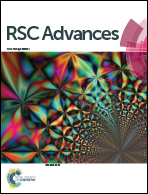Nanostructured RuO2–Co3O4@RuCo-EO with low Ru loading as a high-efficiency electrochemical oxygen evolution catalyst†
Abstract
Electrochemical water splitting technology is considered to be the most reliable method for converting renewable energy such as wind and solar energy into hydrogen. Here, a nanostructured RuO2/Co3O4–RuCo-EO electrode is designed via magnetron sputtering combined with electrochemical oxidation for the oxygen evolution reaction (OER) in an alkaline medium. The optimized RuO2/Co3O4–RuCo-EO electrode with a Ru loading of 0.064 mg cm−2 exhibits excellent electrocatalytic performance with a low overpotential of 220 mV at the current density of 10 mA cm−2 and a low Tafel slope of 59.9 mV dec−1 for the OER. Compared with RuO2 prepared by thermal decomposition, its overpotential is reduced by 82 mV. Meanwhile, compared with RuO2 prepared by magnetron sputtering, the overpotential is also reduced by 74 mV. Furthermore, compared with the RuO2/Ru with core–shell structure (η = 244 mV), the overpotential is still decreased by 24 mV. Therefore, the RuO2/Co3O4–RuCo-EO electrode has excellent OER activity. There are two reasons for the improvement of the OER activity. On the one hand, the core–shell structure is conducive to electron transport, and on the other hand, the addition of Co adjusts the electronic structure of Ru.



 Please wait while we load your content...
Please wait while we load your content...